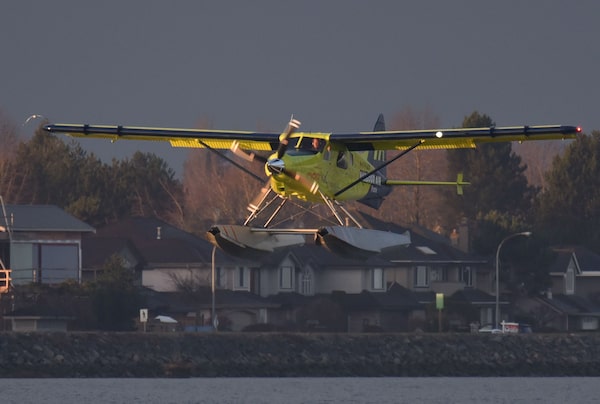
Harbour Air pilot and CEO Greg McDougall flies the world's first all-electric, zero-emission commercial aircraft during a test flight in a de Havilland DHC-2 Beaver from Vancouver International Airport in Richmond, B.C., on Dec. 10, 2019.DON MACKINNON/AFP/Getty Images
The chief executive officer of B.C.-based Harbour Air Seaplanes took to the air at the controls of a float plane equipped with an electric engine Tuesday, a move that puts the company in the global race to develop electric flight and reduce emissions from passenger aircraft.
Greg McDougall, the sole occupant of the aircraft, flew the six-seater de Havilland about 16 kilometres in eight minutes, taking off from the company’s terminal on the Fraser River south of Vancouver International Airport.
It was the first full-fledged flight for the DHC-2 de Havilland Beaver, following a previous test in which it was flown about 60 to 90 metres. The conventional internal combustion engine of the de Havilland has been replaced by a 750-horsepower electric engine developed by magniX, a company based in Redmond, Wash.
"We had no way of knowing really exactly how the aircraft would actually perform until we actually flew it, " Mr. McDougall told a news conference following the flight. “That was the first real time it had flown.”
While the plane has a cutting-edge electric propulsion system, Mr. McDougall noted “the airframe that the motor is attached to is actually one year younger than me, so 62 years old.”
Harbour Air, which carries about 500,000 passengers a year on routes to and from locations such as Victoria, Vancouver Island and the Gulf Islands, is now in a race to perfect electric flight where competitors include Airbus, Sweden’s Heart Aerospace and the Scottish carrier Loganair.
Mr. McDougall, who founded Harbour Air in 1982 with a pair of small seaplanes, said electrification of the transportation industry is a given, prompting the 11 months of work his company has done on the concept.
“Obviously aviation is one of the tougher ones to do, but it’s going to happen," he said. “We need to be at the forefront of it.”
In a statement responding to the Harbour Air test flight, Transport Canada said the federal government is “steadfast” in its belief that transportation electrification is a key part of Canada’s transition to a low-carbon economy.
The federal department says it offers regulatory and certification advice to all industry partners, including Harbour Air, “seeking to develop innovative aviation ideas,” but does not have specific standards for electric-powered aircraft.
“While the industry has begun work in this area, there is much more research and development ahead. Transport Canada will continue to provide support as the industry moves forward with the development of this project.”
Elizabeth May, former leader of the Green Party of Canada, said from the COP 25 climate conference in Madrid on Tuesday that she was monitoring the test with interest.
“I am very excited about the Harbour Air plans to electrify. Something like 80 per cent of flights around the world are less than 1,000 km … so this could be a huge impact on flights and [greenhouse gases],” she wrote in an e-mail exchange.
“A group of Canadian Greens huddled round a laptop at COP25 to watch the test flight! And we cheered with the crowd in Vancouver!”
The David Suzuki Foundation said that air travel, which represents 4.9 per cent of the total human contribution to global warming, is “one of the toughest nuts to crack” in the battle against sources of greenhouse gases.
“The Harbour Air test flight of this all-electric Beaver is an exciting example of a uniquely Canadian climate solution that can play a part in setting us on the course to net-zero emissions by 2050,” Ian Bruce, the foundation’s science and policy director, said.
In Richmond, Stephen Holding, chief instructor for Aerospace Technical Programs at the British Columbia Institute of Technology, was among dozens on the shores of the Fraser River watching Tuesday’s test.
Mr. Holding, by profession an aviation electronics technician, billed the event as a first in electrifying flight for a commercial aircraft.
“They are much further ahead than just about anyone else that I am aware of in the commercial space. There are a number of small, fully electric aircraft out there flying around. There are lots of aircraft on the drawing board,” he said,
“But where the rubber hits the road or the floats hit the water? This is where we’re starting.”
Both Mr. McDougall and Mr. Holding expect it will take somewhere between two- and two-and-a-half years to secure regulatory approval from Transport Canada to allow passengers to be flown in electrified aircraft.
Editor’s note: An earlier version of this article included an incorrect number for the length of most flights.
We have a weekly Western Canada newsletter written by our B.C. and Alberta bureau chiefs, providing a comprehensive package of the news you need to know about the region and its place in the issues facing Canada. Sign up today.
 Ian Bailey
Ian Bailey